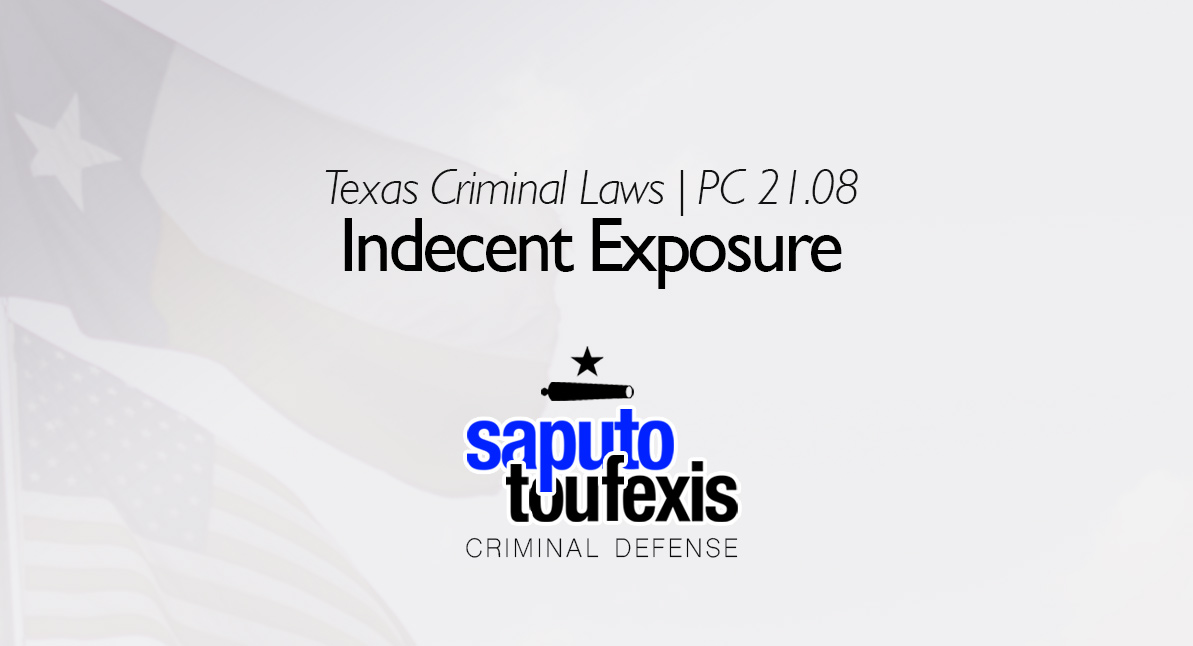The Texas Indecent Exposure law makes it a crime to expose your anus or genitals, if done for sexual purposes, while being reckless about whether someone else might be offended or alarmed.
FAQs about the
Indecent Exposure law in Texas
- What is the current Texas law about Indecent Exposure?
- What is the penalty for a Texas Indecent Exposure offense?
- What changed in 2025>
- How can I be charged with an Indecent Exposure offense in Texas?
- What is the statute of limitations for Indecent Exposure in Texas?
- Can you get probation for Indecent Exposure in Texas?
- Do I have to register as a sex offender in Texas if guilty of Indecent Exposure?
- What level of crime is Indecent Exposure in Texas?
This offense covers actions like urinating in public, masturbating in public, and streaking during a football game. However, as discussed in more detail below, the state might have difficulty proving the necessary intent under some of these circumstances.
Have you been charged with Indecent Exposure? Contact us today to discuss legal representation.
or Text or Call (888) 239-9305
The Texas legislature codified this criminal offense in Texas Penal Code Section 21.08 In 2023, the legislature updated this law by creating a felony enhancement that applies to people who are civilly committed as a “sexually violent predator.” In 2025, the Legislature made only non-substantive housekeeping updates to the Indecent Exposure penalty provision—re-enacting and reorganizing the existing scheme in §21.08(b) without changing it—and those clarifications apply prospectively to offenses committed on or after September 1, 2025.
Indecent Exposure also refers to a subset of the Disorderly Conduct charge that penalizes certain lewd behaviors as a Class C misdemeanor. The Disorderly Conduct subset of Indecent Exposure does not require the state’s attorneys to prove that the exposure was for sexual gratification.
Indecent Exposure is similar to the Public Lewdness offense, but Indecent Exposure does not require any act of intercourse.
The Penal Code classifies the Texas Indecent Exposure law under Title 5 “Offenses Against the Person,” Chapter 21 “Sexual Offenses.” Learn more about the Texas offense of Indecent Exposure below.
What is the current Texas law about Indecent Exposure?
AV Preeminent Texas lawyer Paul Saputo provides the current law defining Indecent Exposure in Penal Code Section §21.08, as follows:[1]
(a) A person commits an offense if he exposes his anus or any part of his genitals with intent to arouse or gratify the sexual desire of any person, and he is reckless about whether another is present who will be offended or alarmed by his act.
The element of Intent
One key element of this offense is the intent required. You must have the intent to “arouse or gratify the sexual desire of any person.” The state’s attorneys have to prove you had this specific intent. If they can convince a jury that you had this intent, then this element has been met. “Any person” means that it does not have to be you. They can try to prove that you intended to arouse someone else. Note also that this other person does not even have to be present at the time the exposure had taken place.
Without such intent, the offense does not apply, although other charges might still be possible. This means that not every instance of displaying the anus or genitals constitutes indecent exposure. For instance, if a group of college students were to “moon” passing cars, showing their buttocks, this action may not be aimed at arousing or gratifying sexual desires. Therefore, under Texas law, they might not be guilty of indecent exposure, though they could be charged with disorderly conduct.
The element of Recklessness
Another key element of this offense is that you have to be “reckless” about whether someone else is present. If you had good reason to believe you were in private, then the state’s lawyers may not be able to meet this element. For instance, it would be challenging for the state’s attorneys to prove you were reckless as to whether someone else could observe you if you were in a closed room that happened to be monitored by a secret video camera.
What is the penalty for a Texas Indecent Exposure offense?
A conviction for Indecent Exposure is punished by default as a Class B misdemeanor,[2] with a maximum possible fine under Texas state law of up to $2,000 and jail time of up to 180 days.
However, the state can seek an enhancement to a Class A misdemeanor by proving that you have a previous Indecent Exposure conviction.[3] And if you have two previous Indecent Exposure convictions, the state can seek a state jail felony enhancement.[4]
Amendments effective in 2023
Effective September 1, 2023, the legislature created a third degree felony enhancement if the actor is civilly committed as a sexually violent predator; this enhancement is now codified at subsection (b)(3).[5]
2025 Update: The legislature amended the penalty provisions in 2025, but it did not change the provisions substantively—just re-labeled and cross-referenced them. As reorganized in 2025, §21.08(b) remains Class B by default; Class A with one prior; state jail felony with two or more priors; and third-degree felony if the actor is civilly committed as a sexually violent predator, with the 2025 changes applying only to offenses committed on or after September 1, 2025.[6]
What changed in 2025>
In 2025, the Legislature re-enacted and amended the Indecent Exposure penalty ladder in §21.08(b), confirmed the third-degree felony enhancement for actors civilly committed as sexually violent predators (originally added in 2023), and set effective-date and applicability rules for offenses, arrests, and sex-offender registration starting September 1, 2025.[7]
- Penalty ladder re-enacted; SVP enhancement retained: The default offense remains a Class B misdemeanor; it is a Class A misdemeanor with one prior §21.08 conviction, a state jail felony with two or more prior §21.08 convictions, and a third-degree felony if the actor is civilly committed as a sexually violent predator under Health & Safety Code Chapter 841.[8]
- Drafting clarification (“or”): SB 1610 uses “or” before subdivision (3), clarifying these are alternative enhancements and avoiding any misreading of cumulative requirements (HB 1620 used the list conjunctive “and”).[9]
- Effective date & prospective application: Both bills take effect September 1, 2025.[10]
- Registration applicability note: SB 1610 provides that its changes to Chapter 62 (sex-offender registration) apply to any person required to register on or after September 1, 2025, regardless of when the underlying offense occurred. This does not change which Indecent Exposure cases trigger registration (second conviction), but it governs how the amended registration provisions apply starting on that date.{SB 1610, 89th Legislature (RS), Section 39; see also [11]}
- No change to elements, limitations, or probation eligibility: The 2025 bills did not alter §21.08(a) elements, the two-year misdemeanor or three-year felony limitations periods, or general community-supervision eligibility rules for this offense.{Texas Penal Code §21.08(a); [12], [13]; [14]}
How can I be charged with an Indecent Exposure offense in Texas?
You can be charged with Indecent Exposure in Texas if the state’s attorneys believe that each of the elements of §21.08(a) as described in the section above have been met.
What is the statute of limitations for Indecent Exposure in Texas?
Misdemeanor level Indecent Exposure charges have a two-year limitations period.[15] Felony level offenses follow the default felony limitations period rule, which specifies a three-year limitations period.[16]
Can you get probation for Indecent Exposure in Texas?
The Texas Code of Criminal Procedure allows both judges and juries to grant probation for Indecent Exposure, and judges are also allowed to accept deferred adjudication plea deals.[17]
Note, however, that no matter the offense, neither judges nor juries may recommend community supervision for any suspended sentence of over 10 years.[18] Also, judges may not grant community supervision after a conviction if (1) the defendant used or exhibited a deadly weapon during the commission of the felony or immediate flight thereafter and (2) the defendant used or exhibited the deadly weapon himself or was a party to the offense and knew that a deadly weapon would be used or exhibited.[19]
Do I have to register as a sex offender in Texas if guilty of Indecent Exposure?
You have to register as a sex offender upon any second violation of the Texas Indecent Exposure offense, but only if the second violation is a conviction – a second deferred adjudication does not qualify.[20]
What level of crime is Indecent Exposure in Texas?
The Penal Code classifies the punishment for Indecent Exposure as a Class B misdemeanor, Class A misdemeanor, state jail felony, or third degree felony, depending on the circumstances.
Learn more about the penalty range for this offense in the section above.
Legal References:
^1. Texas Penal Code §21.08. This law is current as of 2025.^2. Texas Penal Code §21.08(b)^3. Texas Penal Code §21.08(b)(1)^4. Texas Penal Code §21.08(b)(2)^5. Texas Penal Code §21.08(b)(3), as amended by SB 1610, 89th Legislature (RS), Section 2^6. Texas Penal Code §21.08(b)(1)–(3), as amended by SB 1610, 89th Legislature (RS), Section 2, and HB 1620, 89th Legislature (RS), Section 17.001; SB 1610, 89th Legislature (RS), Sections 37 & 43; HB 1620, 89th Legislature (RS), Section 23.001^7. Texas Penal Code §21.08(b), as amended by HB 1620, 89th Legislature (RS), Section 17.001, and SB 1610, 89th Legislature (RS), Section 2^8. Texas Penal Code §21.08(b)(1)–(3), as amended by HB 1620, 89th Legislature (RS), Section 17.001, and SB 1610, 89th Legislature (RS), Section 2^9. SB 1610, 89th Legislature (RS), Section 2; HB 1620, 89th Legislature (RS), Section 17.001^10. HB 1620, 89th Legislature (RS), Article 23, Section 23.001; SB 1610, 89th Legislature (RS), Sections 37 & 43^12. Texas Code of Criminal Procedure art. 62.001(5)(F)^14. Texas Code of Criminal Procedure art. 12.02(a)^15. art. 12.01(8)^16. art. 42A.053, art. 42A.102^17. Code of Criminal Procedure 12.02(a)^18. See Code of Criminal Procedure 12.01(11)^19. See Chapter 42A, Texas Code of Criminal Procedure, Art. 42A.054, Art. 42A.056, Art. 42A.102^20. Art. 42A.053(c), Texas Code of Criminal Procedure^21. Art. 42A.054(b), Texas Code of Criminal Procedure^22. Code of Criminal Procedure, Article 62.001(5)(F)










